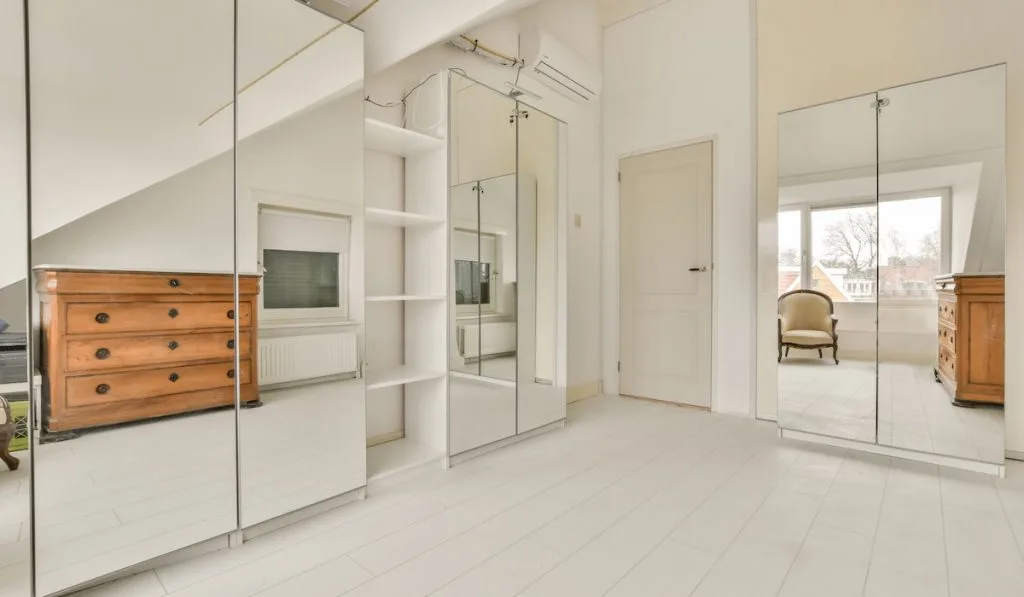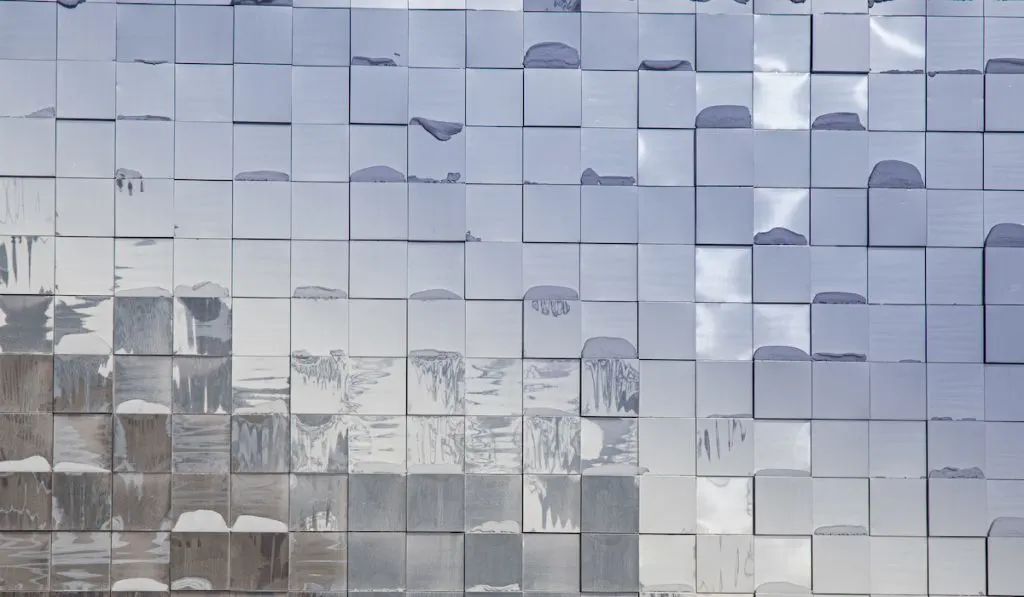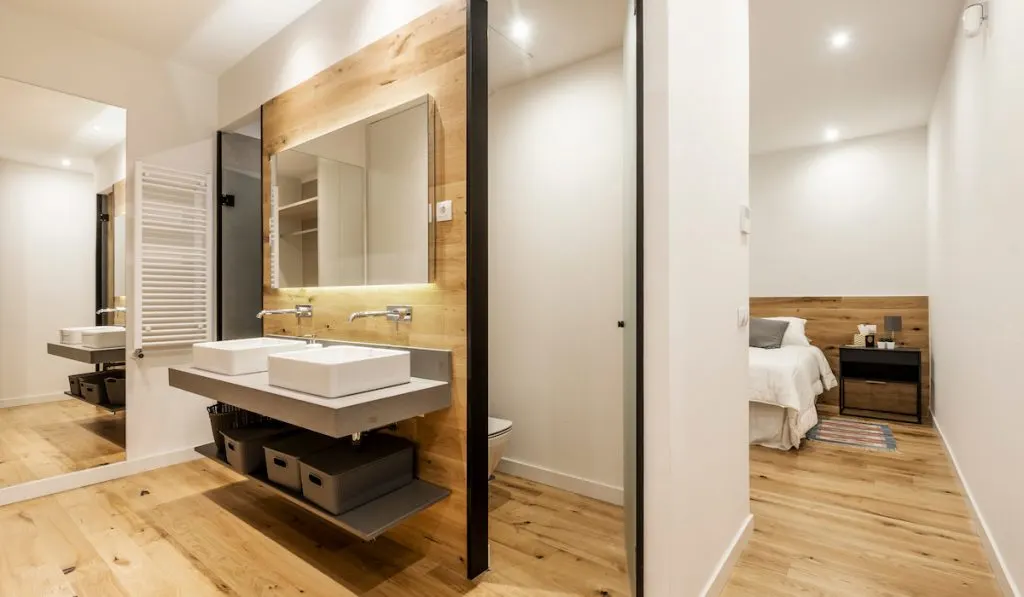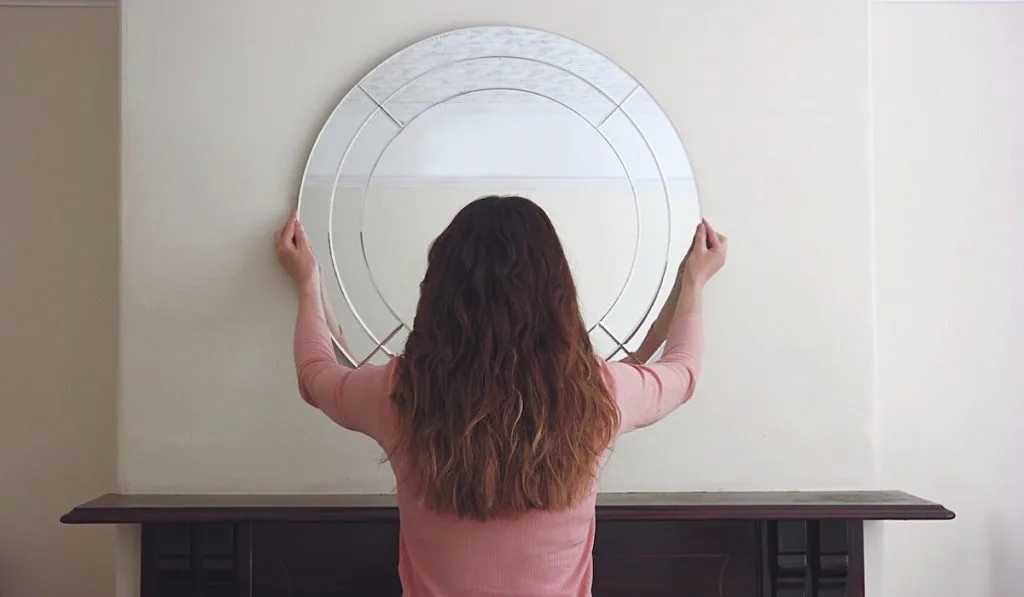A mirror’s frame and size are always the first factors for consideration when customizing one for your space. Depending on the space available or where you want to have the mirror, the size will not be the biggest decision. The real headache comes when choosing whether to have a beveled or non-beveled mirror.
Making this choice can be challenging. This article will help you out with a detailed look at both types, and what you should consider when choosing the type of edging for your mirror that will best compliment your space.

What is a Flat Mirror?
Also known as plane mirrors, flat mirrors are the most popular type of mirrors. Since their surfaces are neither polished nor beveled, light reflects clearly on the surface without any added effects or decorations, making them a favorite in barbershops, dressing rooms, automobile mirrors, and many other places and applications where an accurate representation is necessary.
Why Choose a Flat Mirror?
Plane mirrors must be popular for a reason. In matters of decor, their frames can be curved and customized to fit and accommodate any style and design for any space. Furthermore, they have a timeless and contemporary look that gives a beautiful reflection to any room.
Unlike beveled mirrors, flat mirrors are available in large sizes, meaning that you have more space and room to get creative with your mirrors. As we will see, beveled mirrors always come in certain sizes because of their unique finishing.

What is a Beveled Mirror?
Beveled mirrors are special mirrors whose edges have been cut and trimmed at specific sizes and angles to look as if they are already framed.
Beveling is only done to the edges of the mirror, always leaving the center at the normal mirror thickness of ¼ inch. Depending on the desired design, the edges are trimmed to give a frame-like finish that suits different styles and reflections that are usually not given by standard mirrors.
Since beveled mirrors are customized, they can come in different shapes and sizes depending on their purpose or where you want to use them.
Often found in antique shops and home décor stores, beveled mirrors possess an exquisite and carefully crafted look that reflects light in a unique form, making them ideal decorative or focal point items.
How is Beveling of a Mirror Done?
Bevels are made at the mirror’s edges by creating angled cuts with different designs as required. The thickness of the slant can vary, often ranging from 1/4 of an inch (0.6cm) to 1.2 inches (3cm) thick.
Furthermore, depending on how the light hits the curved finishing, the slants refract the light differently than the center of the mirror, producing eye-catching and interesting visual effects, sometimes even making rainbows.
Glass beveling machines are now the standard method for trimming and lining mirror edges to give the desired slants for finished bevels. Older methods employed hand grinding with papers and grinding wheels of different grits and materials to achieve a uniform bevel.
Curved edges, on the other hand, cannot be done with the auto-beveling equipment but are typically hand-cut with pumice by the fabricator.
Reasons to Choose Beveled Mirrors
When dealing with beveled mirrors, you will realize that they offer so much more than just being there to replace the standard-looking plane mirrors or for the added beauty.
First, beveled mirrors add more depth into a room, thanks to their carefully finished and aesthetically superior edges that refract light and even create rainbow effects.
They also give the room an impression of having more space and making the room look bigger, especially with minimalist designs. They also make gloomy rooms look brighter and add reflection in a case where a room lacks sufficient lighting.
Owing to their slants, beveled mirrors are considered elegant and decorative enough to stand alone because of the vague impression of frames.
Because of the grinding and finishing done to the edges, smaller blemishes and imperfections created during cutting are eliminated and replaced with a clean, polished surface. Furthermore, polishing bevels helps to eliminate the worries of sharp corners or bad edges.
Thanks to their unique craftsmanship, beveled mirrors have a more artistic and rustic look compared to flat mirrors. Owing to their artistry and design, however, they can be costly but on the bright side, you can consider it a worthy investment.

Should You Frame Beveled Mirrors?
Whether framed or not, beveled mirrors always look beautiful.
For beveled mirrors, frames are typically for both decoration and protection from possible damage. They give more design excitement and room for the designer to be creative on how they want the mirror to add to the interior design of the room.
Styles like the Chippendale, Chinese, Federal, Victorian, Baroque, and Venetian can all be complemented by adding stylistic frames to beveled mirrors.
However, some other design styles like Deco, Nouveau, Rustic, and Mexican do not go well with beveled mirrors. For these designs, it would be better to save yourself the beveling costs and opt for plane mirrors.
On the other hand, frameless beveled mirrors look just fine without additional frames, especially for a minimalist design, because the beveled edges give an impression of more space as well as act as a frame.

Where to Use Beveled Mirrors
Either with or without frames, beveled mirrors easily blend with, and work with any design in a room you put them in, without dominating the space.
Owing to their presence, however, beveled mirrors tend to become the focal point of visual attraction in any setting, often lacing the room with unique elegance, especially when placed in libraries, dining rooms, above fireplaces, or a sideboard.
Beveled mirrors have superior powers to make any room look larger and lighter. It is for this feature and the fact that they do not really need any frames that beveled mirrors are fast gaining popularity. Many homeowners decide to replace their bathroom mirrors, dining room mirrors, and even their entryway mirrors with this exquisite design for a new look.
The beveled mirror never lets you down. It easily blends with any décor.

Which is More Expensive?
Compared to plane mirrors, beveled mirrors are slightly more expensive. Owing to the production costs and stylish edgework, the higher price is worth every penny from your pocket.
Technological advancements that have made beveling easier, like auto-beveling machines, have played a major role in cutting production costs, especially for the straight line bevels because they can be economically made.
The cost, however, increases with the width of the beveled edge because more material needs to be removed.
On the other hand, as aforementioned, curved line bevels cannot be done by beveling machines, but are rather done by hand (with stones, pumice, steel wheels, and felt wheels) or by a more specialized machine called a shape-beveling machine.
These tools require specialized skills and manual input to operate. For the extra artistry, they consequently cost more compared to straight-line bevels.
For more prestigious and luxurious looks, beveled mirrors with double or triple beveled edges are available at higher costs.
Should a Mirror’s Application Affect Your Mirror Choice?
At home, mirrors are used in different rooms for different functions, and depending on the location, certain mirrors are best used.
In the entryway, for instance, large beveled wall mirrors are often mounted for an impression of a larger space and to reflect more light for a better visual appeal.
The living room can be decorated with beveled mirrors only at strategic points such as over the fireplaces, or at specific spots to highlight focal points.
Depending on your bathroom, either a beveled or a plane mirror can work because the reflection and the preciseness of the center part are what really matter.
The bedroom, on the other hand, needs a full-length or a medium-sized portrait mirror for dressing and hairstyling. Either a beveled or a plane mirror is good for the bedroom.
For an office setting, a wall-mounted beveled mirror will give a more decorative and reflective look, livening up the office space.
Note that when choosing mirrors for commercial activities, always ensure that they meet the standards and regulations for the respective applications. Some mirrors are best used in beauty parlors, dance studios, and gyms, and others in washrooms.

Conclusion
When choosing your mirror, it all depends on your preference and style. Although beveled mirrors give a superior look compared to plane mirrors, they can be slightly more expensive. Nonetheless, they give your space the extra glam and glow not offered by standard plane mirrors.
However, this is not to say that they fit everywhere. We hope this article helps you make informed decisions when choosing mirrors for your space.
Resources
- https://www.artistry-in-glass.com/what-is-a-beveled-mirror/
- https://medium.com/@mirrorize01/flat-mirror-vs-beveled-mirror-a37f998b840b
- https://www.shinemirrors.com.au/blogs/blog/81927361-advantages-of-beveled-mirrors
- https://www.mirrorize.ca/blog/flat-mirror-vs-beveled-mirror/
- https://www.vedantu.com/physics/uses-of-plane-mirror
- https://guide.archiexpo.com/choosing-the-right-mirror/
